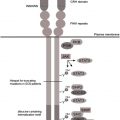Several signaling systems downstream of G-CSFR have been identified that are defective or hyperactivated in myeloid cells of patients with congenital neutropenia: severely reduced expression of myeloid-specific transcription factors LEF-1 and C/EBPα, severely reduced expression and functions of HCLS1 protein, severely reduced expression of neutrophil elastase protein, dramatic compensatory up-regulation of the NAMPT/NAD + /SIRT pathway leading to continuous activation of emergency granulopoiesis via the transcription factor C/EBPβ, and hyperactivation of STAT5 protein by tyrosine phosphorylation.
Key points
- •
Severely reduced expression of myeloid-specific transcription factors, lymphoid enhancer binding factor 1 (LEF-1) and C/EBPα.
- •
Severely reduced expression and functions of HCLS1 protein.
- •
Severely reduced expression of neutrophil elastase (NE) protein.
- •
Dramatic compensatory up-regulation of the nicotinamide phosphoribosyltransferase (NAMPT)/NAD + /SIRT pathway, leading to continuous activation of emergency granulopoiesis via the transcription factor C/EBPβ.
- •
Hyperactivation of STAT5 protein by tyrosine phosphorylation.
Stay updated, free articles. Join our Telegram channel

Full access? Get Clinical Tree




